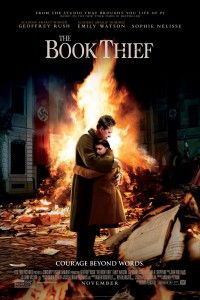The recent release of the enthusiastically anticipated film, The Hunger Games: Catching Fire, completely overshadowed what I thought more worthy of enthusiastic anticipation: the Thanksgiving night debut of The Book Thief. When asked about my plans for break, after expressing my excitement towards seeing my family, my bed, and The Book Thief, I often faced the question, “The what?” Nevertheless, Black Friday found me not in line to buy that seventy-five-percent-off sweater, but rather waiting to purchase that full price movie ticket.
And the film proved well worth the anticipation along with the sacrifice of the sweater, even if my affection for Black Friday shopping was questionable to begin with.

Based on a book published in 2005 by Markus Zusak, the movie shows us part of a young girl’s life in Nazi Germany. The film generally stays true to its novel predecessor, leaving out, as films often must, only the unnecessary. Descriptions of both the book and the film include the setting of The Book Thief in WWII Germany, the hidden Jew in the main character’s basement, and the hobby of the book thief herself: stealing books from grave sites, Nazi book burnings, and a wealthy man’s library.
Though the excitement may initially sound thrilling and the plot may appear dangerous, the movie in fact points more toward the lover of a simple story, not an action-oriented or passion-inspired audience. It rather targets the sort of person that probably enjoyed the book before seeing the movie; more than half of the occupants in the theatre I sat in looked to be older than 60.
Still, the slow-moving plot gains appeal through lovable characters and clever scenes. We meet the Book Thief, Liesel Meminger, as a child of about ten, introduced to us by the surprisingly enticing, velvety voice of the film’s narrator, Death. We first encounter Liesel sitting on a train, lifting her enormous blue eyes to discover her just-dead brother. At his burial we watch her steal her first book, a neglected handbook for gravediggers, which she keeps as a memory of the one buried.
From the graveyard we move to Heaven Street, where Liesel spends the rest of her movie-life. We learn that her mother entrusted Liesel to the foster care system, and as a result, the child meets her new parents. Rosa, a secretly softhearted woman encased in a hostile, insensitive shell, and Hans Hubermann, a large-nosed, winking, immediately lovable father figure, form a duo dubbed “Mama” and “Papa.” The pair repeatedly provoked chuckles from the audience, through Rosa’s witty nagging and Hans’ silent expressions and gentle retaliation.
During her time at Heaven Street, Liesel forms loving relationships between the two foster parents, the Jew, Max, whom the Hubermanns harbor in their basement, and Liesel’s new best friend, the neighborhood energy-filled, “lemon-haired” boy, Rudy.
Though I found the film as a whole enjoyable, many aspects of the story seemed too beautiful for the plot and subject matter they surround. One scene in particular shows Liesel and Rudy just after the latter receives news that Nazi authorities selected him to enter into an early elite training program for the military. We see the two inexpressibly adorable fair-haired children laughing and yelling, “I hate Hitler,” across a clear lake, before a screen of bright green trees and sunshine.
In another more sober scene, following a shower of bombs from foreign planes, the camera focuses on burning rubble, shattered buildings, and a lineup of intact bodies, the occupants of each dismembered home lying peacefully on the ground, simply sprinkled with a little dust.
Overall, I suppose this lack of realistic representation also appeals to the same story-loving audience, who may in turn cringe at accurate gore or the expression of depressed emotions. Nevertheless, for those who crave a spirit-lifting tonic every so often, I found The Book Thief, with its charming protagonist and touching performance just the film to do so.

